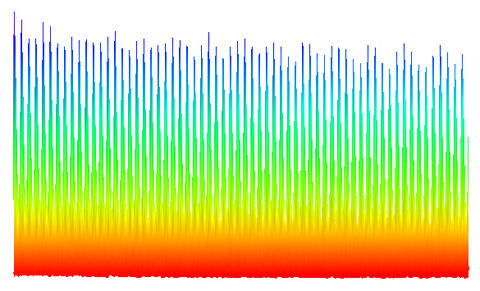
Experimental data from a NIST 'gap-toothed' frequency comb that is false colored to indicate the range from low power (red) to high power (blue). The comb is specially designed for astronomy. Each 'tooth' is a precisely known frequency, and the teeth are widely separated (by 20 gigahertz) in comparison to a standard comb.
Scientists at the University of Konstanz (Germany) and the National Institute of Standards and Technology (NIST) have demonstrated an ultrafast laser that offers a record combination of high speed, short pulses and high average power. The new laser is expected to have a range of applications from gas sensors to communications, but in particular, say researchers, it could boost the sensitivity of astronomical tools searching for other Earthlike planets as much as 100 fold.
The dime-sized laser, described last week at the Conference on Lasers and Electro-Optics,* emits 10 billion pulses per second, each lasting about 40 femtoseconds (quadrillionths of a second). The short, fast pulses make it ideal for use as a "frequency comb"—an ultraprecise technique for measuring frequencies of light. It is 10 times faster than a standard NIST frequency comb, produces much shorter pulses than comparable lasers, and is 100 to 1000 times more powerful than typical high-speed lasers, producing clearer signals in experiments. It was built by Albrecht Bartels at the Center for Applied Photonics of the University of Konstanz in Germany.
As a frequency comb the laser could sharpen the search for planets orbiting distant stars. Astronomers look for slight variations in the apparent colors of starlight over time that are caused by the star wobbling from the gravitational pull of an orbiting planet. The effect is very subtle, and astronomers are limited by the frequency standards they use to calibrate their instruments. Frequency combs could be such superior calibration tools that they would make it possible to detect even tiny Earthlike planets that cause color shifts equivalent to a star wobble of just a few centimeters per second. Current instruments can detect—at best—a wobble of about 1 meter per second.
Frequency combs normally have "teeth"—calibration points—too finely spaced for astronomical instruments to read. The faster laser is one approach to solving this problem. In a related paper,** the NIST group and astronomer Steve Osterman at the University of Colorado at Boulder describe how they can filter out periodic blocks of teeth to create a gap-toothed comb. Bouncing the light between carefully positioned mirrors leaves only every 10th or 20th tooth, which is just right for astronomy.
The dime-sized laser is very simple in construction and produces powerful and extremely well-defined comb teeth, and the filtering technique can cover a broader range of wavelengths. Four or five filtering cavities in parallel would provide a high-precision comb of about 25,000 evenly spaced teeth that spans the visible to near-infrared wavelengths (400 to 1100 nanometers), NIST physicist Scott Diddams says.
A number of major institutions, including the Max-Planck Institute for Quantum Optics and the Harvard Smithsonian Center for Astrophysics are interested in the use of frequency combs for planet discovery. Other potential applications of the new laser include direct measurements of the expansion of the universe, remote sensing of gases for medical or atmospheric studies, and on-the-fly precision control of high-speed optical communications to provide greater versatility in data and time transmissions.
Background on frequency combs and NIST's role in their development can be found at Optical Frequency Combs.
* A. Bartels, D. Heinecke and S.A. Diddams. Passively mode-locked 10 GHz femtosecond Ti:sapphire laser with >1 mW of power per frequency comb mode. Post-deadline paper presented at Conference on Lasers and Electro-Optics (CLEO), San Jose, Calif., May 4-9, 2008.
** D.A. Braje, M. S. Kirchner, S. Osterman, T. Fortier and S. A. Diddams. Astronomical spectrograph calibration with broad-spectrum frequency combs. To appear in European Physics Journal D.

